No Chrysler Building, but plenty of art deco gems to explore in Mumbai
Every evening, crowds swarm Marine Drive, the iconic waterfront on the southern tip of Mumbai, India's financial capital.
Few of the families and tourists who are out taking in the air stop to look back at the depression-rise apartment blocks that line the avenue – a cityscape Salman Rushdie described in the novel The Basis Beneath Her Feet as "a glittering Fine art Deco sweep... non even Rome could boast."
That disregard may be set to change.
The art deco buildings on Marine Drive, together with those on the blocks along the nearby park Oval Maidan, were recognised last year by UNESCO as function of a Globe Heritage site, a distinction that is expected to assistance preserve and promote the neighbourhood. The tag was the result of a 10-year entrada led by heritage activists and local resident groups, one that reflects a growing celebration of Mumbai'due south art deco architecture – even as it is vanishing under the wrecking ball.
"Everyone always talked nearly CST," said Atul Kumar, referring to the Chhatrapati Shivaji Terminus, the metropolis'southward other UNESCO site, a magnificent and much-Instagrammed Victorian Gothic railway station. "But we also had ane of the richest collections of deco in the earth."
Kumar, a resident of Marine Drive, fix upwards the nonprofit Fine art Deco Mumbai in 2022 to raise awareness of these buildings on social media, as well every bit to document them in an online repository. His team has listed more than 375 buildings, including residences, palaces, hotels and cinemas, all built between 1930 and 1950. They approximate the last count – including non only wealthy south Mumbai simply the bazaars of Mohammed Ali Road and center-class neighbourhoods similar Shivaji Park, Matunga and Bandra – will exist around 600 buildings.
That means Mumbai has the world'due south second-largest collection of fine art deco structures, afterwards Miami.
"Anybody always talked about [the Chhatrapati Shivaji Terminus]. But we besides had one of the richest collections of deco in the world." – Atul Kumar
READ> The architect who doesn't blitz perfection – he'due south spent 19 years on his father'due south home
The term art deco, or art decoratifs, gained traction in the 1960s every bit a way to describe a visual style of architecture, design and fashion that emerged in 1920s France. The mode'due south streamlined forms and geometric motifs were inspired by new technologies – ocean liners, airplanes, automobiles, movies – and by everything from cubism to Egyptian imagery.
Mumbai'due south fine art deco structures are not as g as Jazz Age behemoths like New York's Chrysler Building. Instead, they resemble Miami'south laid-back "tropical deco." Every bit UNESCO recognised, the value of Mumbai's deco does not prevarication in the drama of a single structure but in the spirit of the ensemble. This fabric represents the making of mod Bombay, as it was so known.
A confluence of cultural, economical and technological changes transformed the city in the 1930s and 40s. An economic smash attracted thousands of Indians, creating a professional class. The regime adult a reclamation plan to create new land to house them, including Marine Drive, and also created suburbs to the north of the city. Indian architects, many returning from London, along with European designers, congenital the beginning apartments on this state for merchants, industrialists and Indian princes travelling to Europe on the luxury liners of the Peninsular and Oriental Steam Navigation Co.
These architects bankrupt with the British Raj's ornate Victorian Gothic and Indo-Saracenic styles for the latest international trend – described past a leading British architect as "the nudist motion in our profession" – while adapting information technology to the local environment. The choice could be seen as a form of resistance, said Mustansir Dalvi, professor at the Sir J.J. Schoolhouse of Art and Architecture, and as a properties of the freedom movement.
Movie houses, many built by American movie companies similar MGM, glamorised the new aesthetic. A new technology, reinforced concrete, made all of this construction quick and inexpensive. The apartments were snapped up by members of a rising urban elite "who aspired to be modern and were willing to live next to those who were non like themselves," said Dalvi. "They sabbatum next to each other in offices, on commutes, in cinema halls."
He added: "For Mumbai, what art deco represents is cosmopolitanism."
"For Bombay, what art deco represents is cosmopolitanism." – Mustansir Dalvi
In a city increasingly dominated by gated communities and hodgepodge skylines, the deco neighbourhoods call back an historic period of openness and urban coherence. Strict bylaws ensured public spaces and amenities. Buildings had low compound walls. "The wonderful thing nearly the art deco era is that it gave united states of america neighbourhoods, not just single pieces," Dalvi said.
From Mumbai, fine art deco spread to other cities. The style's afterlife in India lasted into the late 1940s and early 50s, and paved the fashion for modernism later on independence in 1947. For decades, however, the contribution of the art deco era was overlooked. Architects worshipped high modernists like Louis Kahn and Le Corbusier while conservationists focused on ancient and colonial monuments.
For years, residents like Nayana Kathpalia, a member of the Oval Trust that supported the heritage campaign, were unaware of the historical or aesthetic value of their buildings. "We just thought it was a skillful place to alive in and look at," Kathpalia said.
The contempo involvement comes just equally this layer of the city is vanishing. The UNESCO tag now protects Marine Drive and Oval Maidan, but everywhere else sometime buildings are falling daily – and with them many memories.
"What is special virtually Mumbai'south architecture, and about art deco in particular, is that unlike Delhi it is not all monuments or public buildings," Kumar said. "It is homes and schools and cinemas, spaces we have lived in, grown up with and can chronicle to."
If y'all want to see some of Mumbai's best art deco buildings firsthand, here are four good places to start.
"What is special about Bombay'due south architecture, and about art deco in detail, is that unlike Delhi information technology is not all monuments or public buildings. It is homes and schools and cinemas, spaces we have lived in, grown up with and tin chronicle to." – Atul Kumar
Imperial AND EROS CINEMAS
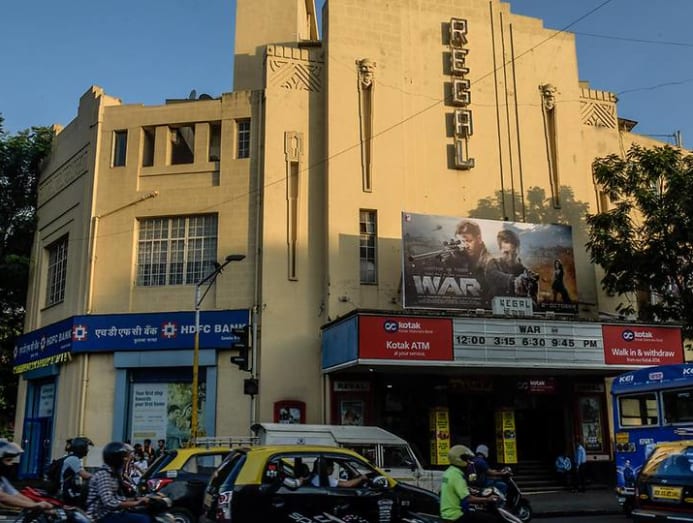
Bombay's art deco cinemas were often funded or owned by American flick companies. Regal is the metropolis's oldest, opening in 1933 with Laurel and Hardy's The Devil's Brother. In a corking analogy of the irresolute times, the theatre was designed by British builder Charles Stevens, whose father Frederic Stevens famously built the Gothic marvel of the Victoria Terminus (now Chhatrapati Shivaji Terminus). The Regal was also the outset building to have an hole-and-corner garage, neon lighting and a soda fountain.
Nearby, the Eros cinema, congenital five years later, is more visually striking with its cream-striped carmine-sandstone facade, ziggurat roofline and a lavish foyer decorated with classical and Indian friezes. (The edifice was designed by Indian architect Sorabji Bhedwar, its interiors by a Czech emigre, Karl Schara.) The 1938 movie theater once also hosted a ballroom and restaurant, advertised as "The Rendezvous of the East." But the Eros is closed, and so if yous want to catch a film, you have to go to the Imperial, which present ways you're more likely to see something from Bollywood than Hollywood.
SHIV SHANTI BHUVAN, OVAL MAIDAN
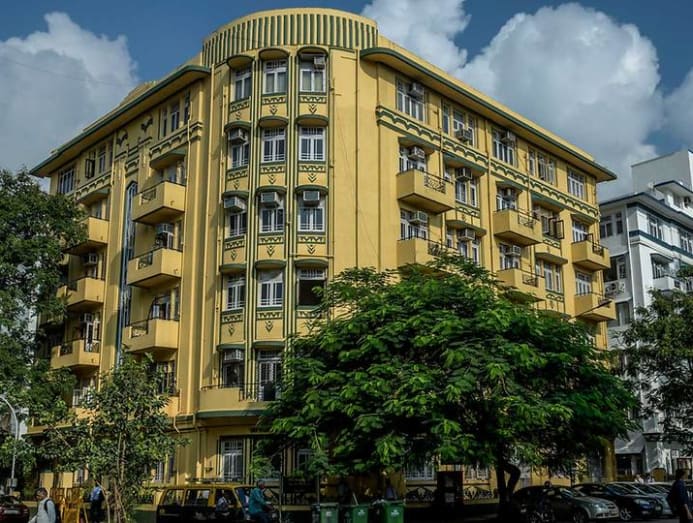
Shiv Shanti Bhuvan is 1 in the line of 1930s art deco apartment blocks that front end the green of the Oval Maidan, looking across information technology to the Victorian spires of the University and High Courtroom. This face-off between ii centuries and styles is what earned the area its heritage designation. The apartments here are amongst the city's primeval and perhaps the most international.
You might think they were thumbing their noses at the imperial grandees across the cricket pitch – except, every bit Dalvi notes, that many of these new apartment buildings have names similar Empress Court and Windsor House. Shiv Shanti, located on a street corner, is one of the most impressive with its yellow-and-light-green color scheme and stack of "eyebrows," or concrete atmospheric condition shades, bulging over the windows, a local adaptation. Note the frozen fountain design over the entrance: A common motif popularised by 1920s French designer Rene Lalique.
NEW Republic of india Balls, FORT
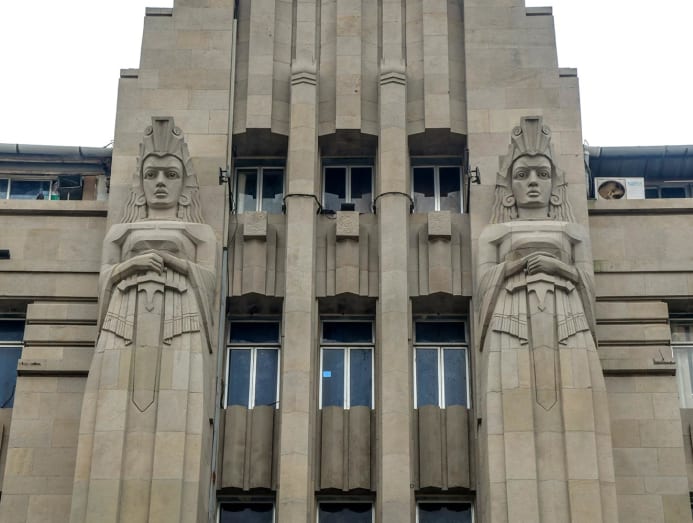
The city'southward fine art deco cinemas exude sometime Hollywood, and its apartments are functional and stylish. By dissimilarity, the fine art deco part buildings are solid, almost classical, as befits their utilise past banks and insurance companies.
In the city'southward Fort neighbourhood, the New India Balls, built in 1936, has stiff vertical lines, flanked by two classical-way figures. Heavy sculptural reliefs, designed by N.G. Pansare, idealise workers: Farmers, potters, women spinning cotton fiber and conveying pots of h2o. You lot'll find Indian flourishes on nearby insurance buildings, too, including sculptures of elephants and of Lakshmi, the goddess of wealth.
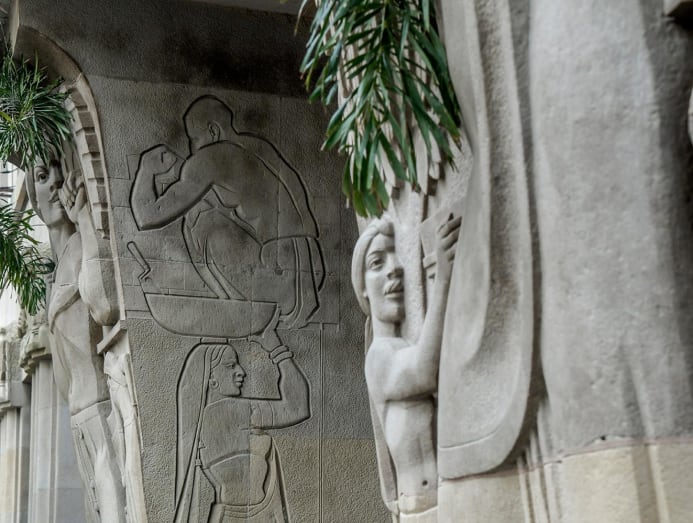
SOONA MAHAL, MARINE Drive
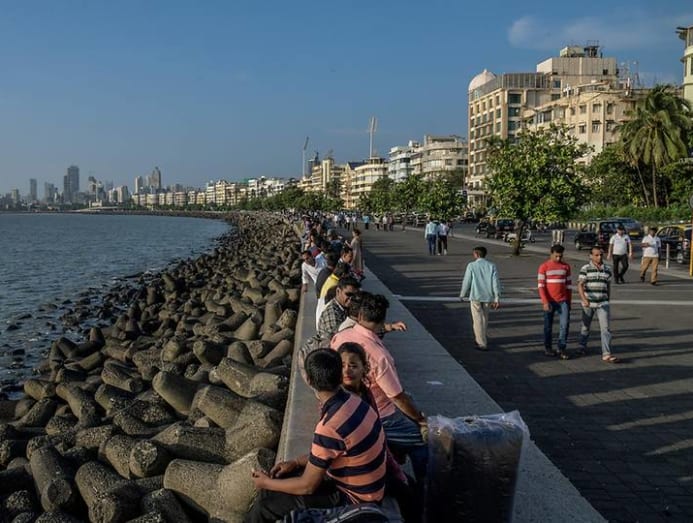
A short stroll from the Oval lies Marine Drive, nicknamed the "Queen's Necklace" for the bend of lights at the waterfront at night. Edifice names here reflect their location – Oceana, Riviera, Chateau Marine – or their Indian buying. Some were originally owned by maharajas and industrialists.
Soona Mahal, congenital and even so owned by the Sidhwa family, is named after the current owner's grandmother. Typically deco are the curved balconies and stiff vertical lines. The round turret on the roof, echoing a ship's bridge, is in keeping with the way's nautical themes. Designed past G.B. Mhatre, an important Indian architect of the time, the building hosted a famous jazz club on the ground floor. Now a music lodge and pizzeria, it's the perfect spot to grab a beer and sentinel the sun set on the Arabian Sea.
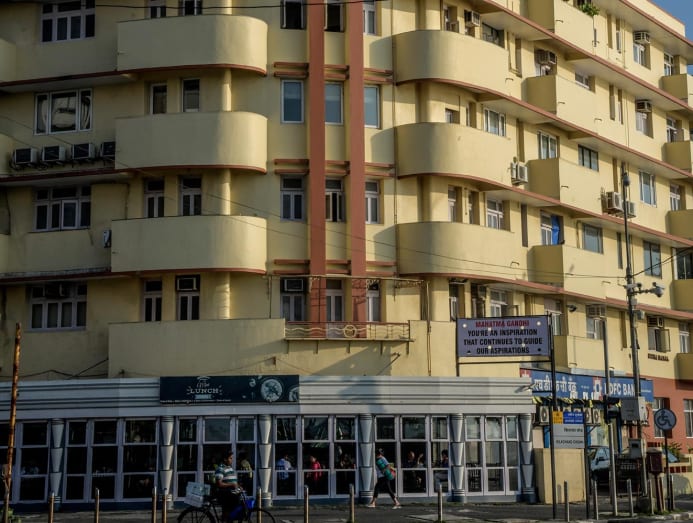
Source: https://cnalifestyle.channelnewsasia.com/experiences/mumbai-art-deco-architecture-176756
0 Response to "No Chrysler Building, but plenty of art deco gems to explore in Mumbai"
Post a Comment